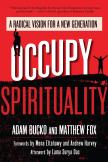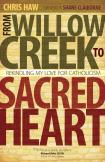The New Young Catholics
Something is stirring among young Catholics. Two recent texts demonstrate two possible options. Matthew Fox and Adam Bucko see a mass youth exodus from organized religion leading to a new, emancipatory spirituality, while Chris Haw finds the specificity of Catholicism oddly liberating.
Occupy Spirituality is a dialogue between young Adam Bucko and elder scholar Matthew Fox. (Fox, who got into hot water with the Vatican some years back, is now an Episcopal priest. Although he makes some very harsh comments about the Catholic Church in the book, he clearly still identifies with the Catholic intellectual tradition.) Light but not fluffy, the book is full of hope, joy and fun. Each chapter opens with quotations from anonymous 20- and 30-somethings about their varied spiritual experiences. Fox and Bucko believe that youth are “interspiritual,” finding fulfillment through social movements like Occupy Wall Street and practices from within faith traditions (prayer, meditation) and without (physical exercise, artistic expression, scientific wonder).
Bucko’s journey of faith is grippingly told: playing music in the subways as a young Polish immigrant, finding peace through meditation, an encounter with a hungry street urchin in India and serving homeless New York youth. Fox’s intellectual biography follows in brief, including the influence of radical Dominican Thomist Marie-Dominique Chenu. Various themes are then covered: vocation, intergenerational dialogue and recent developments including Occupy Wall Street and the New Monasticism (the movement to which Chris Haw belongs).
Readers hoping for a book about the spirituality of the Occupy movement will be disappointed. The book is in the spirit of Occupy, but the chapter devoted to Occupy and the New Monasticism is thin. The “Occupy chaplains,” the “Occupy Faith” network or tents devoted to altars or meditation space at Occupy sites are not discussed. However, the book does contain a foreword on the Arab Spring and a statement from young undocumented immigrant Pancho Ramos-Stierle, arrested while meditating at Occupy Oakland.
For readers looking for a call to intergenerational dialogue, this book is timely but needs to go further. Occupy Spirituality sometimes reads as though alienation from organized religion is a banner behind which all youth are and should be massing. One could read Fox and Bucko without realizing that young Catholics today are as likely to be found chanting the “Tantum Ergo” before a monstrance as doing yoga in a tent in front of Citibank (and sometimes the same people do both). Many young Catholics are hungry for beauty, mystery and transcendence, which is fueling an enthusiasm for traditional practices. Implicit or explicit is often a critique of contemporary society’s restless pursuit of wealth, lack of community, wasteful treatment of creation and quest for empty, instant gratification. For intergenerational dialogue to be effective, older Catholics should hesitate to tell younger Catholics what the “new” or “progressive” thing is (something that, in my experience as a 20-something Catholic, happens quite a lot).
Unlike Occupy Spirituality, Chris Haw’s Willow Creek to Sacred Heart attacks the “spiritual but not religious” trend, which Haw terms “the search for no accent.” Instead of religious neutrality, he encourages a deep encounter with Catholicism and reminds readers that everyone is culturally specific, with a “view from somewhere.” The difference in approaches between the two books is not adversarial; when I chatted on Facebook with Adam Bucko, he had just been to Camden to speak at Haw’s parish.
Haw is a founding member of the New Monasticism, a largely Protestant Evangelical movement that builds intentional communities “in the abandoned places of Empire.” Before writing Willow Creek, Haw teamed up with New Monasticism superstar Shane Claiborne to write Jesus for President, a brightly illustrated, smart hermeneutic with Christian anarchist overtones, presenting the Bible as the story of a struggle against Empire.
Willow Creek is a work of apologetics, a defense of Catholicism, but without the faults common to that genre—it is not triumphalist, haranguing or superficial. William T. Cavanaugh writes in the Afterword, “This is the one book I would put in the hands of people who wonder why they should join the Catholic Church or why they should not leave it.”
Haw recounts his journey from childhood Catholic catechism classes, to a vibrant Evangelical megachurch (Willow Creek), to socially conscious Evangelical projects (including a short stint in jail for protesting the war), to reversion to Catholicism at an inner-city Camden parish (Sacred Heart). As a student at Eastern University, Haw met Fr. Michael Doyle, pastor of Sacred Heart. A long-time activist, Doyle had been one of “the Camden 28,” who broke into a draft office during the Vietnam War. When Father Doyle told Haw about a building he was hoping to convert into a Catholic Worker house, Haw was intrigued. Although they joked that they were more like “Protestant Slackers” than Catholic Workers, he and his future wife moved to Camden to serve the poor of Doyle’s community. And one Good Friday, Haw attended the liturgy at Sacred Heart, was overwhelmed by the beauty and “severity” of the ritual and reverted to the Catholic faith of his childhood.
The second half of the book is a closer theological study, with chapters grouped around common criticisms of Catholicism, including its alleged “paganism” and its penchant for expensive art. Though highly theologically informed, the text has three particularly visible sources: G.K. Chesterton, William T. Cavanaugh and Rene Girard. Haw blends a sort of distributism or agrarian socialism from Chesterton and Wendell Berry with the critique of idolatries of state and market that one finds in Cavanaugh’s work (Torture and Eucharist, The Myth of Religious Violence, Migrations of the Holy). Cavanaugh has long argued that modernity’s split between secular public space and private religious experience is illusory and has lent a dangerous aura of sanctity to immoral military and economic practices. From Rene Girard, Haw draws an understanding of the sacrifice of the Mass as an antisacrifice, a protest against all oppressive “scapegoating.”
The New Monasticism, with which Haw’s Camden intentional community is affiliated, influences his theological approach. The term “New Monasticism” can be misleading. Christian intentional communities of service are not “new,” arguably around since the early Church, and the New Monasticism resembles a Protestant version of the Catholic Worker. Since New Monastics may marry and do not take traditional religious vows, they are not “monastics” in a technical sense either, though they do have a kind of “rule” (a list of “marks”). Nationally there are some Catholic New Monastics like Haw, but it sometimes seems like a new Protestant denomination—one town’s branch that I am familiar with is a friendly, socially conscious Protestant church.
However, the New Monasticism also seems like a social movement, uniting Christians of various denominations to oppose U.S. military aggression and work for economic and environmental justice. Bucko and some others are hopeful that a new, lower-case “new monasticism” might extend beyond the limits of Christianity and form the basis for a new “interspiritual” movement—Bucko is currently finishing a book on the topic. Upper-case, “institutional” New Monasticism remains Christian, predominantly Protestant.
New Monastics like Chris Haw, Shane Claiborne and Jonathan Wilson-Hartgrove share an attraction to the Benedictine virtue of stability, seeing staying put (and gardening) in places of poverty as countering a fast-paced global economy. Claiborne is fascinated by Mother Theresa’s call for everyone to “find their Calcutta,” which for the New Monasticism means relocating, affixing oneself loyally and long-term in a place of dire poverty. In New Monastic literature, there is sometimes a tone of strategic retreat, of keeping Christianity safe and uncorrupted from the world; one notices admiration for the Anabaptists (like the Amish). If the New Monasticism wants to be a transformative movement, its emphasis on monastic stability could prove limiting. Perhaps today’s world is in greater need of mendicants. New Mendicants could confront centers of power, rather than hewing to the periphery and protecting the faith from the incursion of Empire. Urban and mobile, New Mendicants would occupy city centers, and like Haw’s Catholicism, find God in culture.
The New Monasticism and the interspiritual movement might benefit from a dialogue about personal vocation and social strategy. Mother Theresa went to Calcutta in obedience to what she understood to be God’s call, a personal vocation, which is different from having a strategy for mass social change. Some young Catholics are being called to the margins, to the “abandoned places of Empire,” while others are finding their vocation in the heart of the city and the belly of the beast, in nonviolent confrontation in the halls of power, occupying and resisting the Empire head-on. Still others are rediscovering the contemplative life. Across vocations, we can begin a conversation about how to strategically challenge systemic injustice and how to build, in the words of Peter Maurin, a society in which it will be easy to be good.
This article also appeared in print, under the headline “The New Young Catholics,” in the March 23, 2015, issue.









